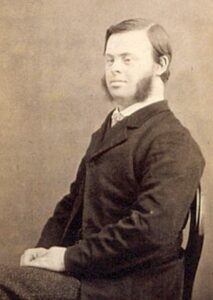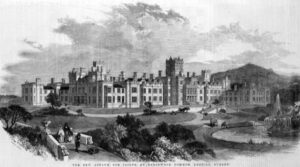JMS Pearce
Hull, England
 |
| Fig 1. A patient at Earlswood photographed by Langdon Down. Via Alchetron. |
Amongst the residents he attended at Earlswood Asylum for Idiots in Redhill, Surrey, John Langdon Down in 1865 began to use an anthropological classification. He identified a group of patients who were mentally delayed and showed a remarkably similar, but previously unrecognized distinctive facial appearance that he described using the language of his day:
So marked is this that when placed side by side it is difficult to believe that the specimens compared are not children of the same parents. The number of idiots who arrange themselves around the Mongolian type is so great, and they present such a close resemblance to one another in mental power, that I shall describe an idiot member of this racial division, selected from the large number to have fallen under my observation…
The face is flat and broad and destitute of prominence. Cheeks are roundish and extended laterally. The eyes are obliquely placed and the internal canthi more than normally distant from one another. The palpebral fissure is very narrow. The lips are large and thick with transverse fissures. The tongue is long, thick and much roughened. The nose is small.Their resemblance to each other was such that when placed side by side, it is difficult to believe that they are not the children of the same parents.
…The Mongolian type of idiocy occurs in more than 10% of the cases which are presented to me. They are always congenital and never result from accidents after uterine life. … They are humorous and a lively sense of the ridiculous often colours their mimicry. The co-ordinating faculty is abnormal, but …by systematic training considerable manipulative skill may be obtained. The circulation is feeble and however much advance is made intellectually in the summer, some amount of retrogression may be expected in the winter. … The life expectancy, however, is far below average…1
Addressing the Obstetric Society in 1876, he emphasized the oblique position of the eyes and the “semi-lunar folds of skin at the inner canthus, which I have been accustomed to describe as epicanthic folds.” He also noted the ears were usually placed further back than in normal children. His Lettsomian lecture, including what he labeled “mongolism,” was presented to The Medical Society of London, titled Mental Affections of Childhood and Youth.2
Down’s syndrome is commonly accompanied by small hands and feet, a single palmar crease, clinodactyly, atrio-ventricular septal defects, and other structural birth defects.3 The varied mental impairments correlate with depletion of neurons and synapses of the anterior frontal and temporal cortex. Secondary changes relate to the early onset of Alzheimer’s disease with abundant neuritic plaques and neurofibrillary tangles.
Langdon Down thought that these patients showed the physical appearances of the Mongol race, a notion reiterated by FG Crookshank in The Mongol in our Midst.4 Langdon Down used the term “mongolism,” which survived until a protest in 1965 by the Mongolian People’s Republic that the term was insulting.5 After considerable and authoritative debate,5,6 the term was dropped.
Remarkably, in his 1932 monograph The Human Eye and its Genetic Disorders, Petrus Johannes Waardenburg (1886–1979) predicted that Down’s syndrome resulted from “a chromosomal deficiency resulting from ‘non-disjunction’ or the converse, a ‘chromosomal duplication.’” Twenty–six years later, Marie Gautier and Jérôme Lejeune discovered the causative trisomy 21.7
John Langdon Haydon Down (1828–1896)
 |
| Fig 2. John Langdon Haydon Down. From the Langdon Down Museum of Learning Disability and the Down’s Syndrome Association UK. |
Langdon Down was a Cornishman, born in the small town Torpoint on the Tamar estuary, son of Joseph Almond Down and his wife, Hanna Haydon. He changed his name by deed poll in 1868 to John Langdon Haydon Langdon-Down though his 1887 Lettsomian lecture showed the name J. Langdon Down.
His eldest sister Ada’s descendants included Sir Walter Langdon Brown (1870–1946), Regius Professor of Physic at Cambridge; the economist John Maynard Keynes; and his brother, the eminent surgeon and Blake scholar Sir Geoffrey Langdon Keynes (1887–1982).
Langdon Down was apprenticed to his father, a grocer apothecary. He studied at the Pharmaceutical Society in Bloomsbury Square before entering the London Hospital as a medical student in 1853. He won several prizes and a gold medal in physiology. On graduation he was appointed medical superintendent to Earlswood Asylum for Idiots in Redhill, Surrey (Fig 3), where he introduced a progressive and humane training program for the residents. Its efficiency and kindness were widely praised.8
At the same time, he was lecturer in comparative anatomy at the London Hospital. In 1859, he took the MD and the MRCP and was appointed assistant physician to the London Hospital; he became FRCP in 1869. His work earned him a thriving Harley Street practice. He left Earlswood in 1868 and bought a new home at Hampton Wick, which he converted to a private institution named Normansfield for the mentally handicapped, especially for the children of the upper classes. He and his wife Mary provided education, occupational therapy, work on the farm, and exercise for the patients. He worked there for the rest of his life. It was continued by his medical sons Percy and Reginald* and his grandson Norman until taken over by the Regional Health Authority in 1974. Langdon Down was grandfather of Stella Langdon Down, wife of the eminent neurologist Lord Russell Brain,9 who was active in Normansfield’s management.
 |
| Fig 3. Earlswood Asylum. From Van Robays J. John Langdon Down (1828 – 1896). , Jun 1, 2016;8(2):131-136. Via Europe PMC. |
He published in 1876 monographs On the education and training of the feeble in mind, and in 1887, The Obstetric Aspects of Idiocy. In his Mental Affections of Childhood and Youth, 1887 he also gave an early description of the Prader–Willi Syndrome of excessive hunger, obesity, low intelligence, and hypogonadism with deletion at Chromosome 15.
He was a handsome, friendly, deeply religious man. He held liberal opinions on race and advanced views on the rights of women to a higher education. Active in civic life, he became an alderman of Middlesex County Council. Aged sixty-seven, he died suddenly in 1896, was cremated and his ashes brought to Normansfield. The Down’s Syndrome Association runs the Langdon Down Museum of Learning Disability and the Langdon Down Centre.
End note
* Ironically, Reginald’s first son, born in 1905, had Down’s syndrome.
References
- Down JLH. Observations on an ethnic classification of idiots. London Hosp Clin Lect Reports 1866;3:259-62. see also: Mental affections of childhood and youth and other papers. In Woods Med. Surg. monographs, 1891;10(2):305-409.
- Langdon Down J. Lettsomian Lectures on Some of the Mental Affections of Childhood and Youth. British Medical Journal 1887;1(1362):256-9.
- Heinke D et al. National Birth Defects Prevention Network. Prevalence of structural birth defects among infants with Down syndrome, 2013-2017: A US population-based study. Birth Defects Res. 2021;113(2):189-202.
- Crookshank FG. The Mongol in our Midst: A Study of Man and his Three Faces. Kegan Paul, 1924.
- Howard-Jones N. On the diagnostic term “Down’s disease.” Med Hist 1979;23:102-8.
- Penrose LS. Mongolism. Brit Med Bull 1961;17:184-9.
- Lejeune J, Gautier M, Turpin R. Human chromosomes in tissue culture. Comptes rendus de l’Académie des Sciences 1959;248:602-3.
- Ward OC. John Langdon Down: The man and the message. Down Syndrome Research and Practice 1999;6:(1):19-24.
- Brain WR. Doctors Past and Present. London: Pitman, 1964. pp. 111-2.
JMS PEARCE is a retired neurologist and author with a particular interest in the history of medicine and science.
Summer 2023 | Sections | Physicians of Note

Leave a Reply